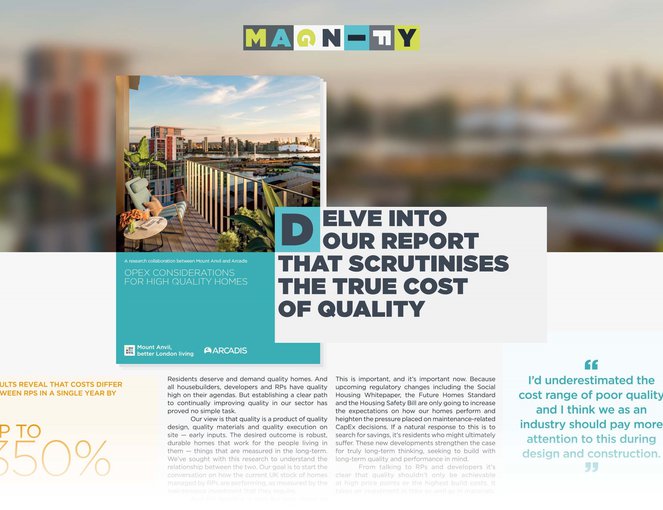
25/11/2021 • What we believe
What is the true cost of poor quality?
In a report launching today, Mount Anvil and Arcadis bring together their findings from an ambitious piece of research which looks at what makes for high quality homes. The report highlights the importance of developers and registered providers investing in quality upfront to avoid a costly future for residents.
Residents deserve and demand quality homes. Quality is not a new idea nor is it a fad – it’s high on housebuilders, developers and RPs agendas, however, establishing a clear path to continually improving quality in the sector has proved no simple task. And as the future looks even more costly, with increasing costs, changes in legislation and additional scrutiny on housing performance. Meaning now is the time for the industry to come together and look afresh at what’s slowing us down from learning faster and improving productivity and performance more rapidly.
The industry talks at length about quality as an overarching theme, but the relationship between capital expenditure, quality and operational cost is much less familiar. On the triangle of cost, time and quality, the research (which used quantitative and qualitative data regarding major housing associations) reveals that we’re much better at measuring first cost and programme duration, and much less clear on operational expenditure as a proxy measure for durability of homes.
Mount Anvil has worked in partnership in London for the last 30 years, and are on a mission to pursue better, differently. Quality has always been foremost on the developer’s agenda which is why it engaged Arcadis to try to establish the true impact of better capex decisions on the long-term opex expenditure that the asset-holder shoulders.
Killian Hurley, Chief Executive of Mount Anvil, said: “Our view is that quality is a product of design, materials and execution - each of these things are early inputs. The desired outcome is robust, durable homes that work for the people living in them – things that are measured in the long-term. We’ve sought with this research to resolve this, and our goal is to start the conversation on how we pursue better, differently, to the benefit of residents in the long run.”
The report analyses data from 20 RPs (managing between 7,000 and 110,000 units) with operations in London (who collectively manage over 770,000 homes). It spans the period March 2012 – March 2020, but excludes 2020 – 2021, due to the potential distortions of the COVID-19 crisis. Arcadis’ work was complexified by the lack of available, consistent data between RPs, therefore they had to change tack and look into publicly available data to get a handle on average annual maintenance costs per unit for each of the analysed RPs, across the 2012-20 timeline. The results reveal that average annual maintenance costs per unit differ significantly between RPs within a single year, often by 350% or more. The range has been decreasing over time, but the costs at each end of the range still differed by 250% in 2020.
Over the eight-year period, the average cost of a notional 1,000-home estate managed by RPs associated with low maintenance cost would have been around half of that of an estate that is in the higher cost segment. Given the commonly-accepted rule of thumb that opex spend ends up being 5-10x capex spend, this is worthy of greater investigation – even if the publicly available data won’t be perfect.
Neal Curtis, Partner at Arcadis, concludes: “The residential sector builds homes which should last 100 years or more. And yet, we’re seeing a number of homes that aren’t able to stand the test of time due to a lack of long-term quality considerations during the initial two-year design and construction phase. As an industry, we need to get better at considering the long term operational and maintenance performance when we build them to make sure that those living in our homes get the most out of them.
“Often design and construction decisions prioritise cost and programme over operation and maintenance, so we need to change where in the asset lifecycle we see the value. In order to do this, we need to collaborate and share asset data between asset owners so we can incorporate these ‘in use’ learnings up front and build right, first time.”
Download the report here
The bitterness of poor-quality lasts once the sweetness of low first cost has faded. Download the full report to kickstart the discussion on what the lack of available data tells us about how we’re prioritizing, and how we need to better collaborate in order to learn.